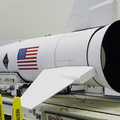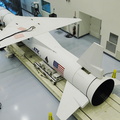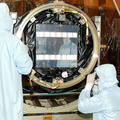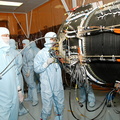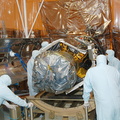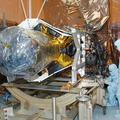
WIKIARCHIVES.SPACE
The Human Spaceflight Archive

Information
- Taken in
- Kennedy Space Center
- Author
- NASA
- Description
- In the Multi-Payload Processing Facility, the Pegasus XL launch vehicle is in position for mating of the Galaxy Evolution Explorer (GALEX) satellite. The GALEX, set to launch April 2 from Cape Canaveral Air Force Station, will carry into space an orbiting telescope that will observe a million galaxies across 10 billion years of cosmic history to help astronomers determine when the stars and elements we see today had their origins. The spacecraft will sweep the skies for 28 months using state-of-the-art ultraviolet detectors to single out galaxies dominated by young, hot, short-lived stars that give off a great deal of energy at that wavelength. These galaxies are actively creating stars, and therefore provide a window into the history and causes of star formation in galaxies.
- Created on
- Thursday 13 March 2003
- Albums
-
Locations / OSM-4.915832801313164
US SPACE PROGRAM / SATELLITES / PEGASUS XL / GALEX / Rocket preparation
- Source link
- https://science.ksc.nasa.gov/gallery/photos/2003/
- Visits
- 38
- Rating score
- 4.86 (1 rate)
- Rate this photo
- License
- CC BY-NC-ND
- Modified by WikiArchives
- No (original)
- Downloads
- 1
Powered by Piwigo
